| Article ID | Journal | Published Year | Pages | File Type |
|---|---|---|---|---|
| 6395602 | Food Research International | 2015 | 9 Pages |
Abstract
The headspace of six roasted Coffea arabica coffees, both brew and powder, of different geographical origins (Brazil, Ethiopia, Guatemala, Costa Rica, Colombia, and India) was analysed by Proton Transfer Reaction-Time of Flight-Mass Spectrometry. For the first time, in the case of coffee, a Switching Reagent Ion System has been used to produce different ionisation agents: H3O+, NO+ and O2+. Significant differences were found among volatile concentrations for the different origins both for powders and brews, in particular high concentrations of terpenes for Ethiopia, sulphur compounds for Colombia and thiazoles for Brazil and India. Effective classification models have been set for the different ionisation modes and data fusion of the data obtained by different reagent ions further reduced the classification errors.
Related Topics
Life Sciences
Agricultural and Biological Sciences
Food Science
Authors
Sine Yener, Andrea Romano, Luca Cappellin, Pablo M. Granitto, Eugenio Aprea, Luciano Navarini, Tilmann D. Märk, Flavia Gasperi, Franco Biasioli,
